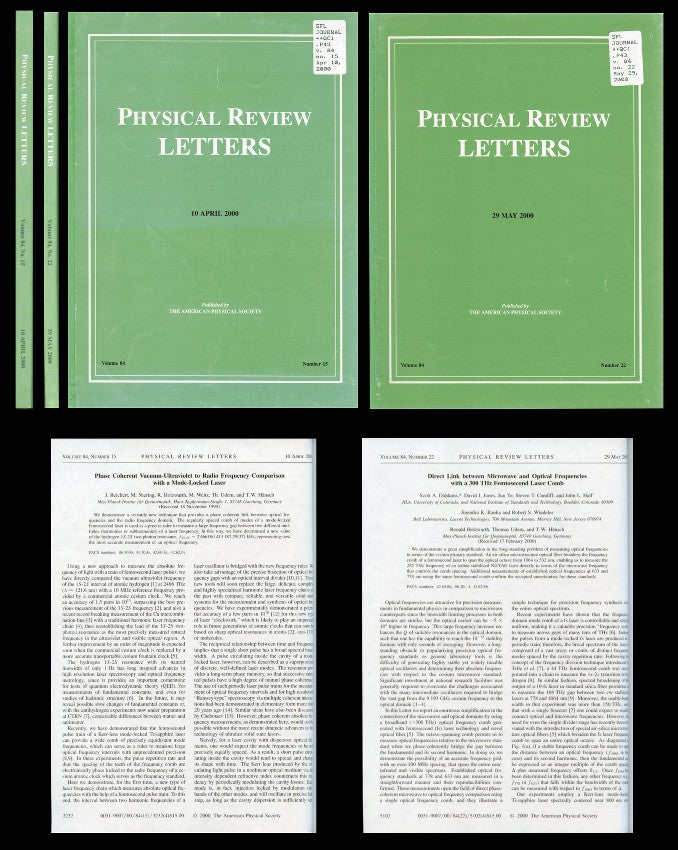Phase Coherent Vacuum-Ultraviolet to Radio Frequency Comparison With a Mode-Locked Laser in Physical Review Letters, Vol. 84, No. 15, 10 April 2000, pp. 3232-3236 WITH Direct Link Between Microwave and Optical Frequencies With a 300 THz Femtosecond Laser Comb in Physical Review Letters, Vol. 84, No. 22, 29 May 2000, pp. 5102-5105
New York: American Physical Society, 2000. 1st Edition. FIRST EDITION ISSUES IN ORIGINAL WRAPS TWO PAPERS BY HÄNSCH & HALL FOR THEIR NOBEL PRIZE WINNING WORK ON THE DEVELOPMENT OF LASER-BASED PRECISION SPECTROSCOPY AND THEIR DEVELOPMENT OF THE FREQUENCY COMB TECHNIQUE. American physicist John Lewis "Jan" Hall and German physicist Theodor Wolfgang Hänsch shared one half of the 2005 Nobel Prize in Physics for these “contributions to the development of laser-based precision spectroscopy, including the optical frequency comb technique. Their laser-based precision spectroscopy meant that atoms could again be employed as references to stabilize the frequency of laser light. In other words, scientists could now “tune a laser wavelength to an optical transition within an atom” (Hessmo, “Laser-based precision spectroscopy and the optical frequency comb technique”, Heidelberg, 15 October, 2005).
Precision spectroscopy is the ability to measure a frequency accurately. Precision laser spectroscopy creates optical frequency standards substantially superior to the present Cesium time standard. The frequency comb technique allows scientists to transfer the stability of an optical reference to other frequencies where electronics can be used to handle signals. Put another way, the frequency comb functions as would a ruler. “When the frequency of a particular radiation is determined, it can be compared to the extremely acute comb spectral lines, until one is found that ‘fits’” (Wikipedia).
The work Hall and Hänsch put forth in these papers presents their “development of laser-based precision spectroscopy, that is, the determination of the colour of the light of atoms and molecules with extreme precision. [Their contributions] made it possible to measure frequencies with an accuracy of fifteen digits. Lasers with extremely sharp colours can now be constructed and with the frequency comb technique precise readings can be made of light of all colours. This technique makes it possible to carry out studies of, for example, the stability of the constants of nature over time and to develop extremely accurate clocks and improved GPS technology” (Nobel Prize Committee).
The other half of the 2005 prize went to Roy J. Glauber "for his contribution to the quantum theory of optical coherence” (Nobel Prize Committee). Item #744
CONDITION & DETAILS: New York: American Physical Society. Two entire issues, first editions in original wraps. 4to. Ex-libris with small library stickers on the front and back covers; barely visible library stamp at the edge of issue No. 15; issue 22 has a small stamp on the first page of the journal (not a paper relevant here). Mild scuffs and edge wear covers. Both are bright and very clean throughout. Very good +.
Price: $325.00

